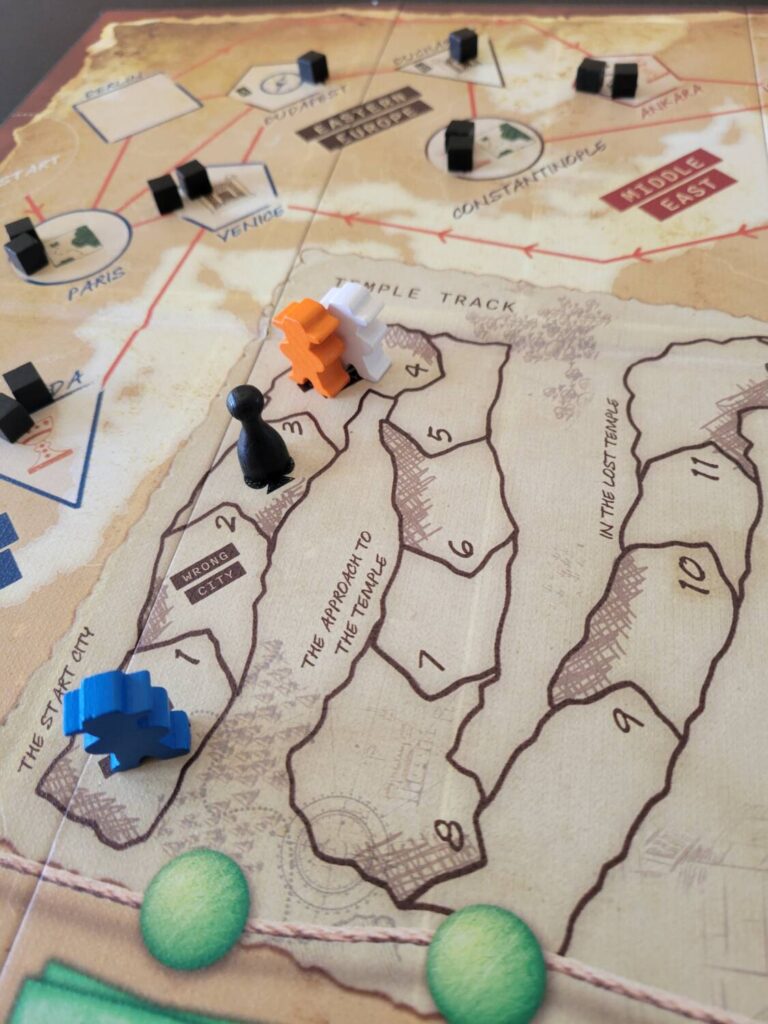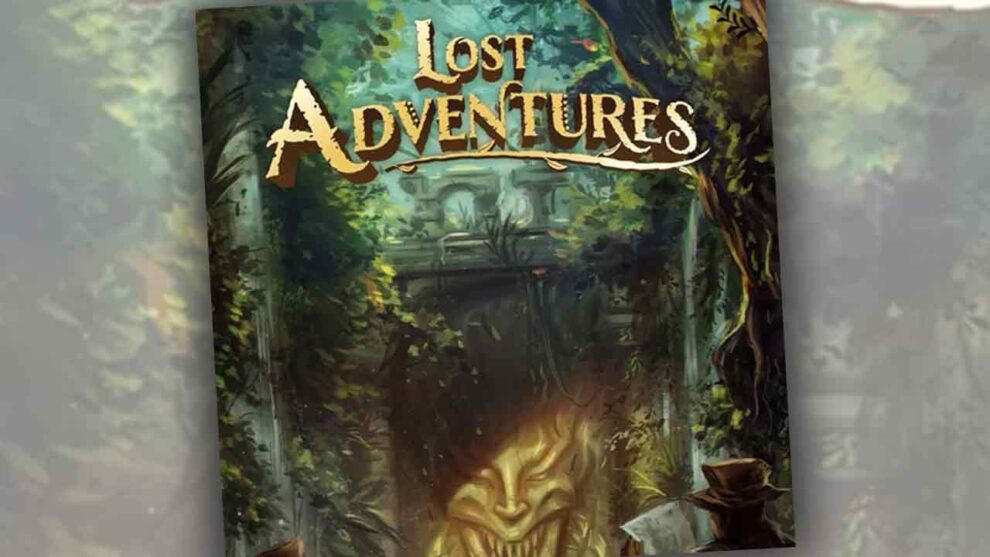Lost Adventures has a nostalgic charm to it that reminds me of board games I enjoyed as a kid. I don’t get tickled that way often, especially by most contemporary designs. Like the big-on-luck, low on analysis games of yore, this game’s commitment to its own bit is noteworthy.
While I’m not much of an Indiana Jones guy, Lost Adventures ticks all the requisite boxes: a race against other unsavory adventurers to find clues to some esoteric mystery; an evil Nazi-adjacent organization that’s chasing you around a map; and, finally, a series of challenges that will test your moral character and greed. Here’s how it works:
Players move around a point-to-point map that cross-references locations with cards set around the perimeter of the board. Each card gives you pieces of information about the challenges you’ll face in the temple in the second half of the game. Also, each card has cubes assigned to it that represent how many “clue points” you need to take a peek at it. Each player starts with two cards in a tableau in front of them. The cards have red symbols and blue symbols. I’ll get to the former in a minute, but the latter gives you clue points when you search for clues. This is done with a fairly simple mechanism. If you move to a pentagonal shaped city, you flip a pentagon card, and you see how many blue symbols in your tableau match symbols on the revealed card. That’s your base amount of clue points. Additionally, the Nazi pawn automatically chases you around the board and reduces your total, and you can sometimes take “hubris” for additional clue points.

What is hubris? Well, it’s something I have in enormous amounts, but as far as the game goes, if you take more than 15 hubris, you automatically lose the game, and, on top of this, you’ll have to purge all the hubris you’ve accumulated in a final challenge at the end of the game.
Each time you visit a city to search for clues, you can take one of the cubes that was allocated to that city’s card(s), which makes it cheaper for other players to look at the card, but also gives you a valuable resource.

At the end of a turn, a player adds a new card to their tableau or flips a card to a more powerful side. You can only have five cards in play, however. There are a few other bits to this phase of the game, but that’s the gist.
After players have done five movement turns, the second part of the game starts. Basically, you take the knowledge that you’ve learned and you use it. There are several tasks that you have to overcome, all of which move you along on a track on the game board. You write on your player sheet your guess for each stage of the temple.
First, each player gets a starting position based on how well they guess where the temple is, which is a specific city on the board that you’ve determined by learning its region and/or its shape.
Then, players make a series of bids, and this is where the red symbols come in. There are four bidding rounds, each paired with a card that has a symbol that a player may or may not have discovered. Each player makes a secret bid, and they are all revealed simultaneously. The card is revealed. Players subtract the number of matching red symbols in their tableau from their bid, and take the difference as hubris. For each other player (including the bad guy, who gets a random card-driven bid) a player outbids, they move a step on the track. Then, there’s a chalice you have to correctly pick from a total of four, and a final symbol matching bid.
Then, to cap it all off, you have the FINAL CHALLENGE. Every player who is behind the bad guy on the track is eliminated from the game, and each player who remains has to get rid of all of their hubris. You flip four cards from the game deck, and remove hubris for each hat symbol you get. You can spend those cubes that you were collecting earlier to reduce hubris. If you manage to get rid of all your hubris, and you’re the farthest along on the track, you win. Otherwise, you lose.

There’s a certain nostalgic and rustic flair to Lost Adventures, not so much as to its source material but its relationship to a sort of “feelings-first” school of design. It reminds me of some of the early Fantasy Flight games, where you had minor mechanical innovations that were draped together in service of a specific feeling. I think of Fury of Dracula, where the game evokes more of the feeling of cat-and-mouse with card effects than is actually present. From a mechanical perspective, Lost Adventures is nothing particularly novel or clever–it’s push-your-luck blind bidding at best, and the deduction isn’t really that clever or complicated.

That said, the game does make you feel clever, and it makes you feel like an adventurer boldly spitting in the face of a deity, and maybe getting their face melted off as a consequence.
As an additional note, I highly recommend tracking down a copy of designer Jeff Warrender’s Sands of Time if you’re a fan of novel empire building games, and his game The Acts of the Evangelists is also a treat.










